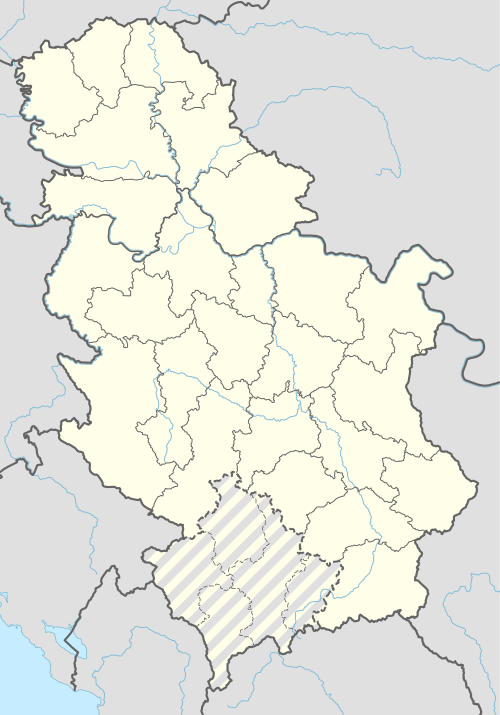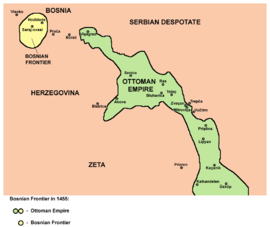Stari Ras
Ras (Serbian Cyrillic: Рас; Latin: Arsa), known in modern Serbian historiography as Stari Ras (Serbian Cyrillic: Стари Рас, meaning Old Ras), is a medieval fortress located in the vicinity of former market-place of Staro Trgovište, some 11 km west of modern day city of Novi Pazar in Serbia.
| Stari Ras | |
|---|---|
| Native name Serbian: Стари Рас | |
 Overview of the Stari Ras | |
| Location | Near Novi Pazar, Serbia |
| Coordinates | 43°7′42″N 20°24′56″E |
| Elevation | 755 m (2,477.0 ft) |
| Official name: Stari Ras and Sopoćani | |
| Type | Cultural |
| Criteria | i, iii |
| Designated | 1979 (3rd session) |
| Reference no. | 96 |
| State Party | |
| Region | Europe and North America |
| Official name: СТАРИ РАС СА СОПОЋАНИМА | |
| Type | Monument of Culture of Exceptional Importance |
| Designated | 1990 |
| Reference no. | ПКИЦ 24[1] |
 Location of Stari Ras within Serbia | |

Old Ras was one of the first capitals of the medieval Serbian state of Raška, and the most important one for quite a long period of time. Located in today's region of Raška, the city was positioned in the center of the early medieval state. It was founded before the 9th century and was deserted sometime in the 13th century. Its favorable position in the area known as Old Serbia, along the Raška gorge, on the crossroads and trading routes between neighbouring regions of Zeta and Bosnia in the west and Kosovo and Metohija in the south added to its importance as a city.
Today the fortress of Arsa lies in mostly unenclosed and unprotected ruins. However, there are plans for future reconstruction of the site. In the close vicinity of Arsa there is impressive group of medieval monuments consisting of fortresses, old market-places, churches and monasteries. Serbian medieval Monastery of Sopoćani near Arsa is a reminder of the contacts between Western world and the Byzantine world. The site of Stari Ras, in combination with the nearby Monastery of Sopoćani, is already a UNESCO World Heritage Site, and Stari Ras monastery (12th century) is being reconstructed and it too may be included on the UNESCO World Heritage List with the site. Stari Ras and Sopoćani World Heritage site is not far from another UNESCO World Heritage Site of Serbia, the magnificent medieval monastery and churches of Studenica. The 6th century Church of Saint Apostles Peter and Paul is one of the oldest early medieval churches in Serbia.
Stari Ras was declared Monument of Culture of Exceptional Importance in 1990, and it is protected by Republic of Serbia.[1]
History
Archeological findings of fortified structures and early churches from the area of Stari Ras, dated from 4th to 6th century, correspond to testimony of Byzantine historian Procopius who wrote that Roman castellum of Arsa in the province of Dardania was refortified during the reign of emperor Justinian I (527-565).[2]
With the arrival of Slavs in the 6th century and the final collapse of Byzantine rule in Dardania at the beginning of the 7th century, the fort of Arsa was destroyed. To newly settled Serbs, old Arsa was known as Ras. It soon became a peripheral place for Serbia. In the early stages of Serbian statehood it was the easternmost town, bordering the First Bulgarian Empire, also annexed by the Bulgars in 924–927.
A bishopric for inner Serbia was founded probably in Ras in the time of major ecclesiastical events that took place around the Council of Constantinople in 869-870 and the Council of Constantinople in 879–880.[3]
In the time of emperor John I Tzimiskes (r. 969-976), Byzantine rule was briefly restored in the region of Ras, and protospatharios John was appointed as governor (catepan) of Ras.[4][5]
After the victories of emperor Basil II and the restoration of Byzantine power in Southeastern Europe (1018), Ras became the political and church center of Byzantine Serbia. In the imperial charters of Basil II from 1019 and 1020, rights and jurisdictions of the autonomous Archbishopric of Ohrid were established. One of the bishoprics in its jurisdiction was that of Ras, with the seat at the Church of the Holy Apostles Peter and Paul. During the Hungarian-Byzantine War (1127–29), the Serbs fought on the Hungarian side, re-conquering Ras which had been under Byzantine rule. In the next war (1149–51) the Byzantines seized Ras again.
A late 12th-century cave monastery existed in the region north of the Studenica monastery.[6]
During the 14th century there was an important market-place below the Stari Ras, Trgovište, that started to develop. By the mid-15th century, in the time of the final Ottoman conquest of the region, another market-place was developing some 11 km to the east. The older place was known as Staro Trgovište ("old market-place", in Turkish: Eski Pazar) and younger as Novo Trgovište ("new market-place", Turkish: Yeni Pazar). The latter developed into the modern city of Novi Pazar.

 Đurđevi stupovi, 12th century
Đurđevi stupovi, 12th century Sopoćani, 13th century
Sopoćani, 13th century
Monuments
- The oldest early medieval church-building in Serbia, the Church of the Holy Apostles Peter and Paul, was founded sometime during the 9th century on foundations of an Early Christian church. According to tradition, Serbian Prince Petar Gojniković (r. 892-917) was entombed in this church.
See also
| Wikimedia Commons has media related to Stari Ras. |
- Monument of Culture of Exceptional Importance
- Tourism in Serbia
- Nemanjić dynasty
- Spatial Cultural-Historical Units of Great Importance
References
- Monuments of Culture in Serbia: СТАРИ РАС СА СОПОЋАНИМА (SANU) (in Serbian and English)
- The World of the Slavs : Studies of the East, West and South Slavs at Google Books p. 216
- The Entry of the Slavs Into Christendom: An Introduction to the Medieval History of the Slavs at Google Books p. 67-68, 208-209
- Stephenson, Paul (2003). The Legend of Basil the Bulgar-slayer. Cambridge University Press. p. 42. ISBN 978-0-521-81530-7.
- Byzantium in the year 1000. BRILL. 2003. p. 122. ISBN 978-90-04-12097-6.
- Patrich, Joseph (2001-01-01). The Sabaite Heritage in the Orthodox Church from the Fifth Century to the Present. Peeters Publishers. ISBN 9789042909762.
Further reading
- Mrkobrad, D. 1997, "Ras-Postenje: Phases in the development of the fortress", Zbornik radova Vizantološkog instituta, no. 36, pp. 203–219.
- "О ПРОУЧАВАЊУ И ПУБЛИКОВАЊУ УТВРЂЕНИХ МЕСТА У СРБИЈИ ИЗ VII-X СТОЛЕЋА".
- Damjanović, L., Holclajtner-Antunović, I., Mioč, U.B., Bikić, V., Milovanović, D. and Evans, I.R., 2011. Archaeometric study of medieval pottery excavated at Stari (Old) Ras, Serbia. Journal of Archaeological Science, 38(4), pp. 818–828. doi:10.1016/j.jas.2010.11.004
- Borojević, K., 2005. Nutrition and environment in medieval Serbia: charred cereal, weed and fruit remains from the fortress of Ras. Vegetation history and archaeobotany, 14(4), pp. 453–464. doi:10.1007/s00334-005-0092-9
- Borojević, K., 2002. The analysis of plant remains from the fortress Ras-the 12th and the beginning of the 13th century. Starinar, (52), pp. 191–205. doi:10.2298/STA0252191B
- Vanderheyde, C., 2002. M. POPOVIĆ, The Fortress of Ras (= Archaeological Institute Monographies, n° 34), Belgrade, 1999.
- Dinić, B. and Janković, M., 1979. ABO blood groups in medieval remains (Ras, Novi Pazar, X-XII AD). Journal of Human Evolution, 8(7), pp. 715–718.
- Popović, M., Stepanović, N., Ristić, M., Botorić, D., Borić, N., Radovanović, I., Vilotić, D., Blažić, S., Maksimović, L. and Ivanišević, V., 1999. Tvrđava Ras: The Fortress of Ras. Arheološki institut.
- Живковић, Тибор (2002). Јужни Словени под византијском влашћу 600-1025 (South Slavs under the Byzantine Rule 600-1025). Београд: Историјски институт САНУ, Службени гласник.CS1 maint: ref=harv (link)
- Živković, Tibor (2008). Forging unity: The South Slavs between East and West 550-1150. Belgrade: The Institute of History, Čigoja štampa.CS1 maint: ref=harv (link)

